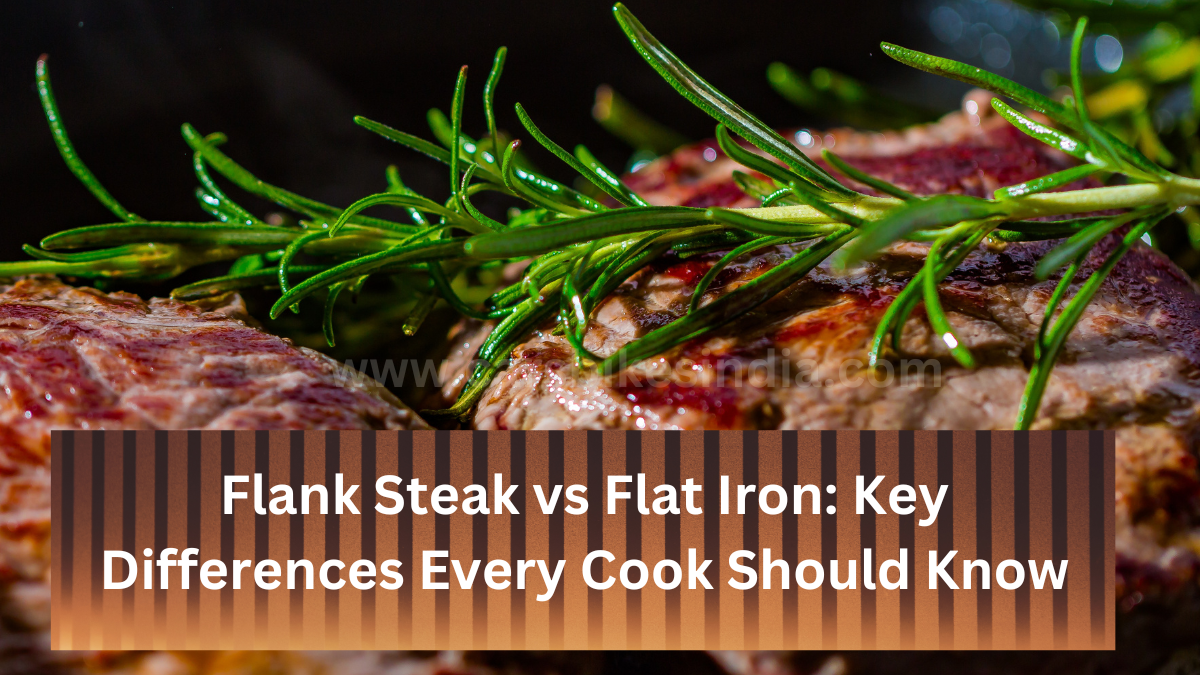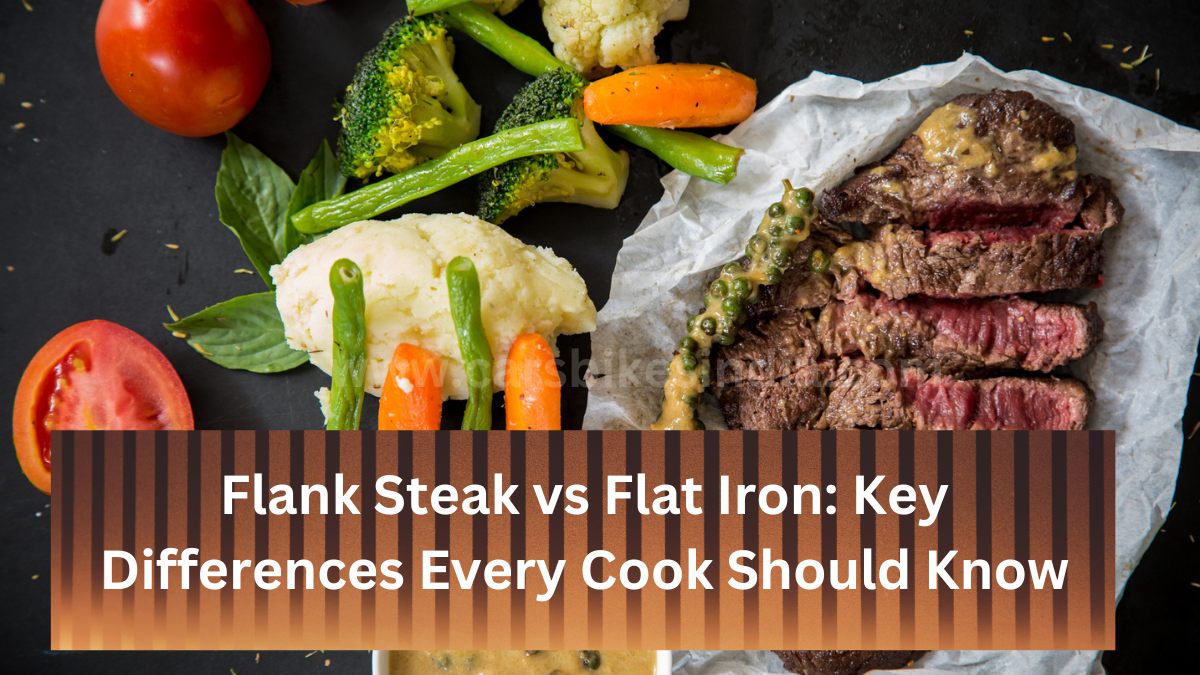Flank Steak vs Flat Iron: When it comes to selecting the perfect cut of beef, flank steak and flat iron steak are two popular choices that often appear on menus and in grocery stores. Both cuts are known for their rich flavor and versatility, but they differ in terms of texture, cooking methods, and best uses. Understanding the distinctions between flank steak and flat iron steak can help you choose the right cut for your next meal, whether you’re grilling, pan-searing, or preparing a stir-fry.

In this article, we’ll explore the key differences between flank steak and flat iron steak, focusing on their origins, texture, flavor profiles, and cooking tips.
What is Flank Steak?
Flank steak is a cut of beef that comes from the lower abdominal muscles, specifically the “flank” area of the cow, which is located just below the rib cage and near the hind legs. It’s a long, flat, and relatively lean cut of meat, prized for its beefy flavor and slightly coarse texture.
Characteristics of Flank Steak:
- Texture: Flank steak is known for its fibrous, grainy texture. It has long muscle fibers running throughout the cut, which can make it tougher than other steaks if not cooked or sliced correctly.
- Flavor: Flank steak offers a robust, beefy flavor that is especially appealing in dishes requiring bold seasoning or marinades. It easily absorbs marinades, which helps to tenderize the meat and enhance its natural taste.
- Cooking: To avoid toughness, flank steak should be cooked quickly over high heat, either by grilling, broiling, or searing. It’s typically served medium-rare to medium to retain tenderness. Once cooked, it should be sliced thinly against the grain to make the meat more tender.
Best Uses for Flank Steak:
- Stir-fries: Flank steak’s thin, long strips make it perfect for stir-fry dishes, as it cooks quickly and absorbs sauces well.
- Tacos and Fajitas: The rich flavor of flank steak complements Mexican dishes, especially when grilled and sliced thinly.
- Grilled Steak Salads: Sliced flank steak on top of a salad adds a hearty, flavorful protein component.
Flank Steak vs Flat Iron: Flank steak is highly versatile and affordable, but its tougher texture means it requires careful preparation to bring out its best qualities.

What is Flat Iron Steak?
Flat iron steak comes from the shoulder area of the cow, specifically from the “chuck” section. It’s a relatively new cut, developed in the early 2000s by meat researchers who sought to create a tender and affordable cut of steak from the chuck. The name “flat iron” comes from the steak’s resemblance to an old-fashioned metal flat iron, being flat and somewhat rectangular.
Characteristics of Flat Iron Steak
- Texture: Flat iron steak is exceptionally tender, second only to filet mignon. It has a more uniform, fine texture than flank steak, with marbling throughout that gives it tenderness and juiciness.
- Flavor: Flat iron steak has a rich, buttery flavor due to its higher fat content compared to flank steak. It’s known for being tender while still offering a robust beef flavor, making it a popular choice for steak lovers.
- Cooking: Flat iron steak is incredibly versatile when it comes to cooking. It can be grilled, pan-seared, or broiled to perfection. Like flank steak, it’s best cooked to medium-rare or medium to retain its tenderness. However, flat iron steak doesn’t require as much attention to slicing as flank steak, though slicing it against the grain can still enhance its tenderness.
Best Uses for Flat Iron Steak
- Steak Sandwiches: Flat iron steak’s tenderness makes it an excellent choice for thinly sliced steak sandwiches.
- Grilled Steak: Whether for a backyard BBQ or a fine dining experience, flat iron steak performs beautifully on the grill, producing a juicy, flavorful steak with minimal effort.
- Pan-seared Steak: Its tender texture and marbling make it ideal for pan-searing, creating a caramelized crust while keeping the inside juicy.
Flank Steak vs Flat Iron: Flat iron steak offers a balance between tenderness and flavor, making it a versatile option for a variety of dishes. It’s often more affordable than premium cuts like ribeye or filet mignon, offering excellent value for its quality.

Flank Steak vs. Flat Iron Steak: Key Differences
- Location and Cut:
- Flank steak is taken from the lower abdominal area, while flat iron steak is from the shoulder (chuck) section of the cow.
- Texture:
- Flank steak has a coarser, fibrous texture and can be tougher if overcooked or not sliced properly.
- Flat iron steak is known for its tenderness and fine texture, making it easier to cook and eat without needing special slicing techniques.
- Flavor:
- Both cuts have a strong beefy flavor, but flat iron steak has more marbling and a richer, buttery taste due to its higher fat content.
- Flank steak, while flavorful, is leaner and can be slightly chewier.
- Cooking Methods:
- Flank steak benefits from quick, high-heat cooking methods like grilling or broiling and is often marinated to improve its tenderness.
- Flat iron steak can be grilled, seared, or broiled and is more forgiving if slightly overcooked, thanks to its tenderness.
- Best Uses:
- Flank steak is perfect for dishes like stir-fries, tacos, or fajitas where thin slicing is required.
- Flat iron steak shines in steak-centric dishes where tenderness is prized, such as steak sandwiches, steak salads, or grilled steak dishes.
Choosing Between Flank Steak vs Flat Iron Steak
When deciding between flank steak and flat iron steak, your choice will largely depend on the dish you are preparing and the texture you’re seeking. If you’re making a dish where thin, flavorful slices of meat are ideal (like fajitas or stir-fries), flank steak is a great option. On the other hand, if you want a tender, juicy steak for grilling or searing, flat iron steak is a fantastic choice that offers tenderness akin to more expensive cuts at a lower price point.
Flank Steak vs Flat Iron: Both cuts are flavorful, affordable, and versatile, but their unique characteristics make them better suited to specific cooking methods and recipes. With the right preparation, either cut can be the star of your next meal.
Conclusion
Flank Steak vs Flat Iron: Flank steak and flat iron steak both have their place in the kitchen. While flank steak is leaner and has a slightly chewier texture, it excels in dishes where bold marinades and thin slicing bring out its best qualities. Flat iron steak, on the other hand, is tender and juicy, offering a steakhouse-quality experience at home. Whether you’re grilling, pan-searing, or stir-frying, knowing the strengths of each cut will help you choose the right steak for your meal.


